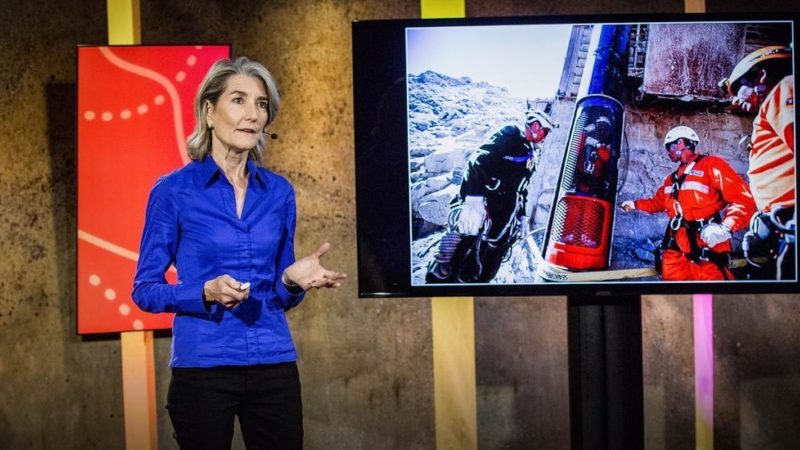Bridging the Strategic Gap: How to Empower Our Schools' Middle Leaders
The power that middle leaders have in schools is the ability and responsibility to make vision a reality.
“Middle leaders” include division directors or principals; department chairs; directors of diversity, equity and inclusion; directors of technology or innovation; instructional coaches; and more. These leaders bridge the “strategic gap” in schools. Whereas vision and strategy are ultimately set by a governing board of trustees or directors, middle leaders are often charged with executing that vision and strategy. They find they have to reconcile ambitious goals with the day-to-day life of school and to pursue aspirational visions while acknowledging and serving the lived experiences of students, teachers, and their families.
Since August 2020, we’ve been working with school leaders on how to navigate leadership during and beyond pandemic education. Most recently, last month, we spent five days with 46 school leaders, most of them middle leaders, in GOA’s Leadership Institute, an online program that introduced five core competencies.
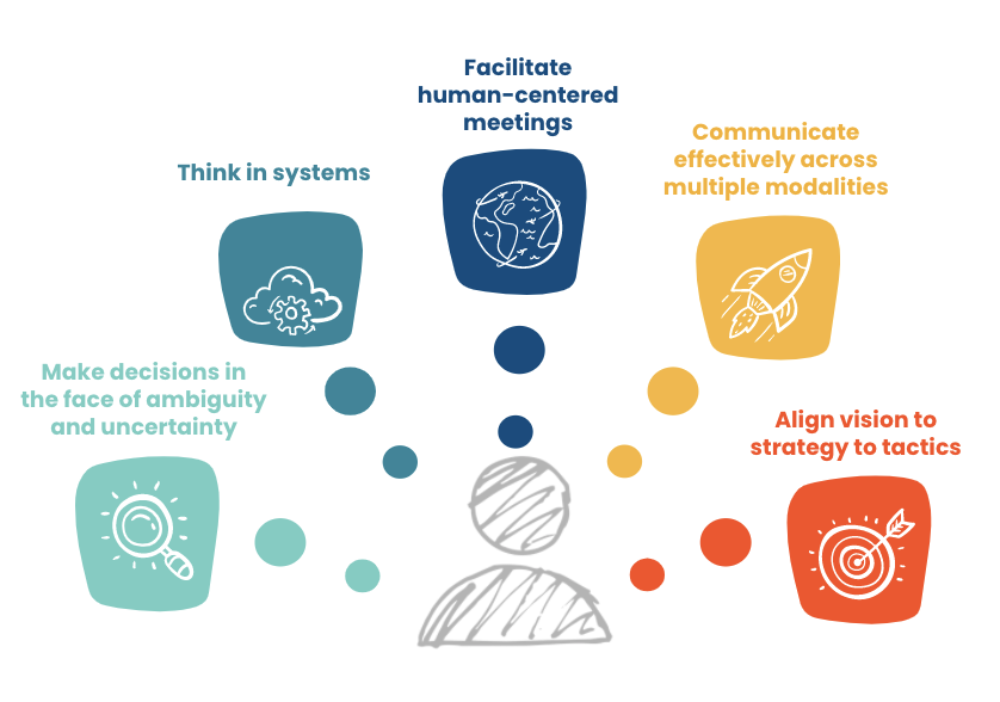
GOA's Portrait of a School Leader
We believe these skills have always been important to modern, relevant school leadership, but pandemic education has made them urgent. Our focus during the institute was to introduce these skills through practical, concrete strategies middle leaders can apply to their daily work.
Communicate Effectively Across Multiple Modalities
We launched the institute with a focus on a skill leaders have told us again and again matters more than ever and is changing more than ever: communication. Using principles of user experience design, we asked leaders to consider how they can diversify their communication strategies to be more impactful, inclusive, and satisfying to a variety of stakeholders. Specifically, we emphasized two skills worth developing: creating effective videos and using visualization to communicate complex ideas. Developing the ability to use different media at different times for different audiences is a skill that will matter far beyond pandemic education.
To begin the process of designing strategic communications, we asked leaders to complete a simple worksheet that asked them to identify a critical communication by time of year, to reflect on how a change of modality might improve that communication, and to consider the potential impact on their target audience.
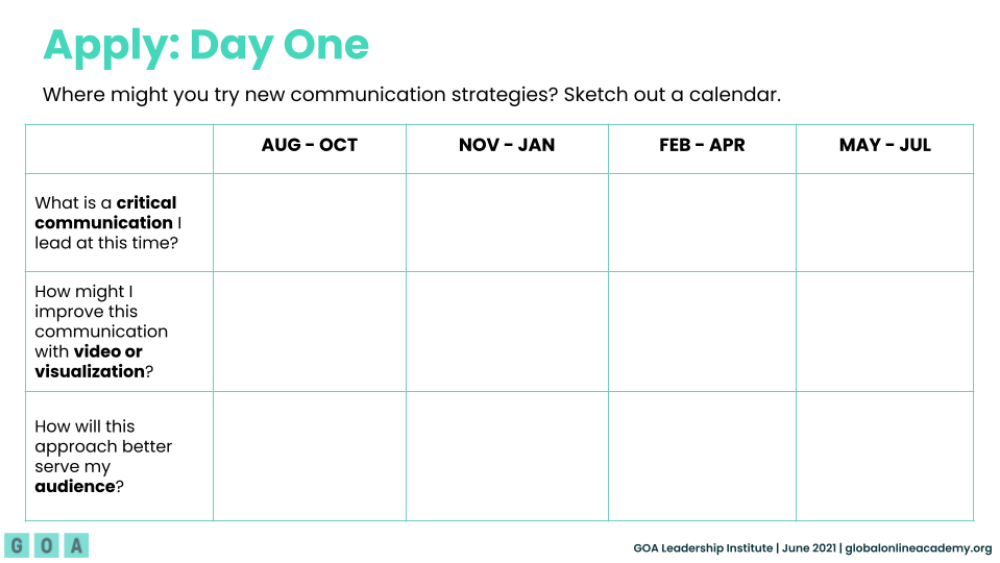
Each day of the GOA Leadership Institute had an Apply activity. Here, participants were asked to think about critical communications throughout the year and imagine new ways to diversify them for different audiences.
As Tye Campbell (Gilman School) reflected, “I realized that too often I forget that people remember more of what they see and experience than what they read. Further, I am also reminded that communication really matters to me and that I need to make more time to communicate effectively, and by using means other than email.”
Facilitate Human-Centered Meetings
Meetings play a central role in school leadership: when (and how often) to have them, whom to include in them, and how to design them to be effective uses of time. At the heart of well-designed gatherings is psychological safety. People must feel that their presence has meaning and value and that the environment is one where they can safely express ideas. Our “Warm-Up” for this day’s work at the institute was Amy Edmonson’s TED Talk on the importance of psychological safety in building effective teams.
Amy Edmonson | How to Turn a Group of Strangers into a Team
TED Talk
We emphasized that the design of meetings should be responsive and differentiated. The purpose and format of meetings should shift according to time of year and objectives. In addition, a variety of strategies should be employed to engage participants: meetings tend to favor the verbose and the extroverted, and creating opportunities for silent reflection or writing, for the use of online tools to make thinking visible, and for more structured protocols and thinking routines all support more equitable, human-centered participation.
In her reflection on the day’s work, Anne Love (Concordia International School Shanghai) wrote, “Thinking through the ebbs and flows of the year is very powerful. I wonder if drawing a collective journey map of the year would be helpful?”
Jennifer Rose (The Wardlaw-Hartridge School) added, “In a diverse workplace, understanding different cultural norms for interaction is incredibly important, and taking note of 'task-oriented' personas vs. 'relational-oriented' personas will help create a safe and effective team.”
Make Decisions in the Face of Ambiguity and Uncertainty
Leaders often feel the need and desire to make the best decisions and find solutions to resolve the fear and anxiety that can come with ambiguity and uncertainty, especially in the last year and a half. As we worked with leaders, however, we realized that many of the problems they were trying to solve weren’t "problems to be solved"; they were polarities to be managed.
A polarity gives us two ideas that are complementary and interdependent. Common polarities to be managed in schools include:
- Student-centered and Teacher-centered
- Directive and Consensus
- Accommodation and Assimilation
- Stability and Change
In the institute, we used polarity mapping to break down potential polarities that school leaders faced to begin to shift away from an "either/or" mindset to a "both/and" one.
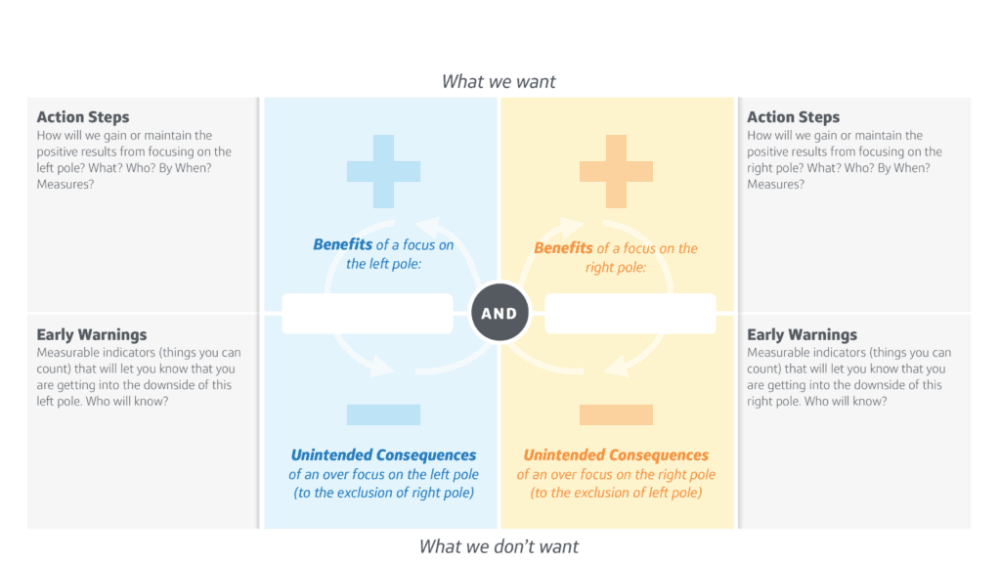
Polarity mapping is about articulating ways in which we keep complex tensions in balance rather than trying to solve them. Source: UX Mastery
Brandon Rogers (Parker School) saw polarity mapping as an opportunity to reframe how his team thinks about challenging topics: “As a new administrator to a school...I've realized many teachers want clarity and certainty. I think, therefore, these polarity exercises are great for exploring how ambiguity and uncertainty do not equal failure or weakness.”
Think in Systems
Making thinking visible and visual was a core theme of the institute, and it’s a strategy that aligns well with systems thinking, a critical skill for leaders of complex organizations. Instead of trying to break things down into discrete and manageable parts, systems thinking embraces the interconnectedness of our schools, attempting to understand how a decision we make in one area affects webs of relationships and processes.
Many leaders in the institute were committed to changing systems at their schools, especially in pursuit of equity, and we encouraged them to use systems mapping to take a first step towards seeing the system in order to understand the system. By visualizing systems, leaders can begin to identify the assumptions and decisions that drive the design of that system, and also identify targets for change.
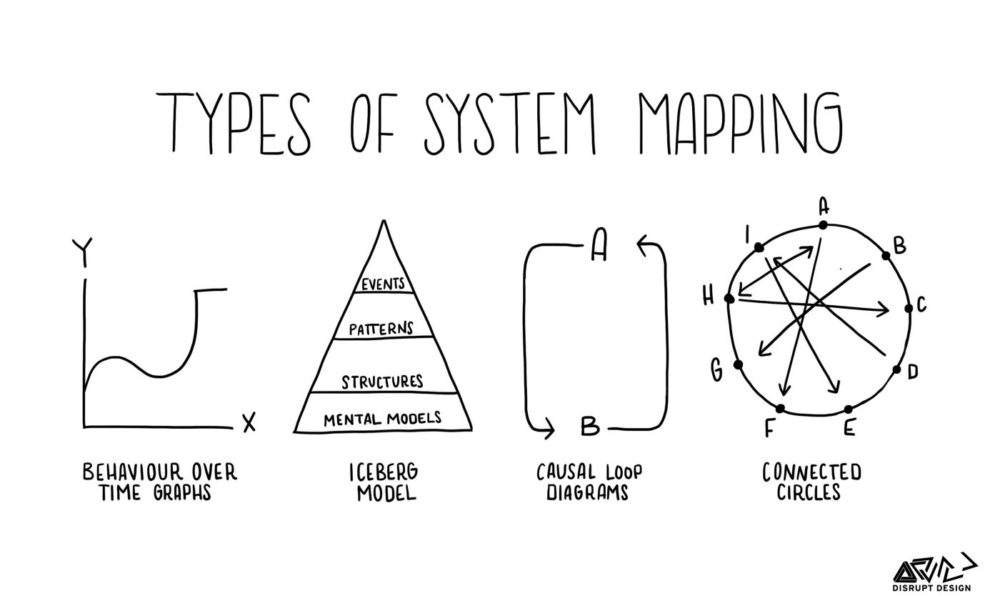
Systems mapping is an effective way to make the first step of systems thinking: see the system. Source: Leyla Acaroglu
Heather Polhemus (Parker School) mapped her school’s onboarding system: “I recently hired a new teacher and decided to map [the onboarding] process. I found that it was helpful to think of it through the teacher's lens; asking myself what would she want to know, what does she need to feel comfortable in our larger community, as well as on campus, in our school community... I can see where this activity would be helpful for many different processes.”
Align Vision to Strategy to Tactics
We wrapped up the institute by focusing on how leaders can better align vision to strategy to tactics in their schools. Echoing the focus of the first day of the institute, this skill requires clear, purpose-driven communication.
Providing clarity for our departments or teams starts with definitions: What is a “vision” and how does that differ from your mission and values? How are you defining “strategy” and “tactics"? How do these terms (or the terms you use at your school) relate to each other? We reviewed different examples of terms, definitions, and hierarchies as well as asked leaders to (re)write their school’s vision statement.
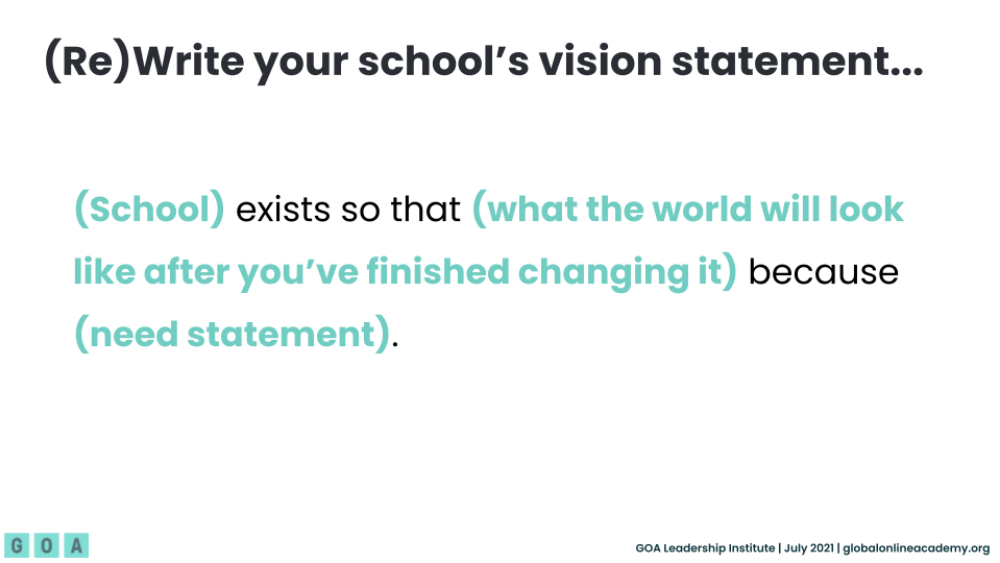
Shannon Rankin (Sewickley Academy) reminded the group that middle leaders must be vigilant about keeping the vision in mind as they do their jobs: “We get focused on the day-to-day, but I think that this will help us keep in mind the big picture of how our department can support our strategic plan.”
Middle Leaders Need Support, Connection, and Learning Tailored to Them
One of the most important lessons we’ve learned in nearly a year of working with school leaders is that they want and need to connect across schools. Most schools have only one academic dean, one dean of students, or one director of diversity, equity, and inclusion. How might we help these leaders find peers in the same role at other schools? How might we create the time, space, and opportunities needed to ensure these leaders are building the networks and skills they need to succeed?
For more resources on school leadership during and beyond pandemic education, read these GOA articles:
The GOA Design Lab works with school leaders to transform academic programs. Explore our strategic consulting and design audit services.


